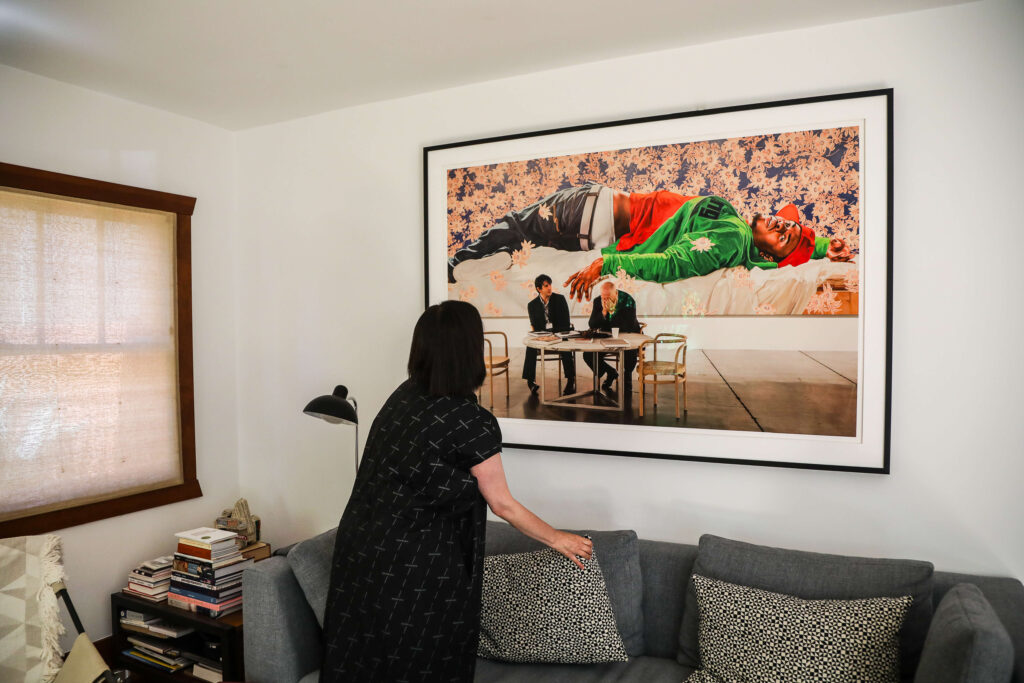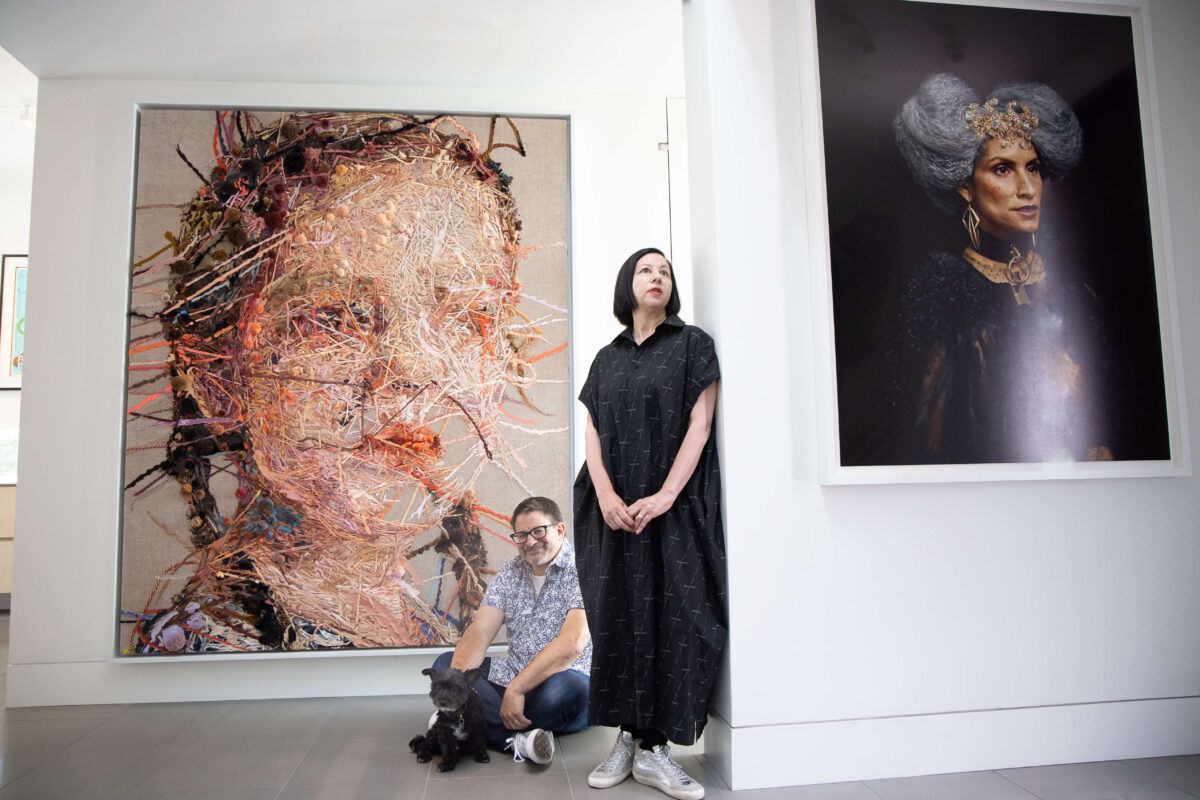A Palo Alto Couple’s Passion for Collecting
The Greek statesman Aristides is credited with saying, “Collection is obsession organized.” Palo Alto art collector Pamela Hornik is quick to agree with the obsession aspect of that statement. She and her husband David have, over the past 12 years, amassed a prestigious collection of paintings, prints, photographs and sculpture that are displayed in two adjacent homes located on a quiet, leafy street near Stanford University. They have also become known for sharing their collection by loaning and donating art to regional museums and galleries.
Although Pamela laughingly confesses that she would like the collection to be more organized, it is clear, upon touring the Hornik homes, that she is extremely knowledgeable about art and passionate about being a collector. As a child, she collected Steiff animals and David has a large collection devoted to Alice in Wonderland volumes. “We have that wacky gene that makes you a collector,” she explains.
David, a venture capitalist, grew up in small towns in Massachusetts and New Hampshire before heading west to attend Stanford University. Pamela was born in Queens, New York, but lived overseas (Panama, Puerto Rico) prior to enrolling at the University of California at Berkeley. Neither one had exposure to art as children.
The Horniks were drawn to art collecting as a mutual activity after the last of their four children left home. “Some couples decide to play golf; we decided to collect art,” Pamela says, before further clarifying, “This is not an investment collection. We don’t work with advisors and flip the art. It is a passion collection.”
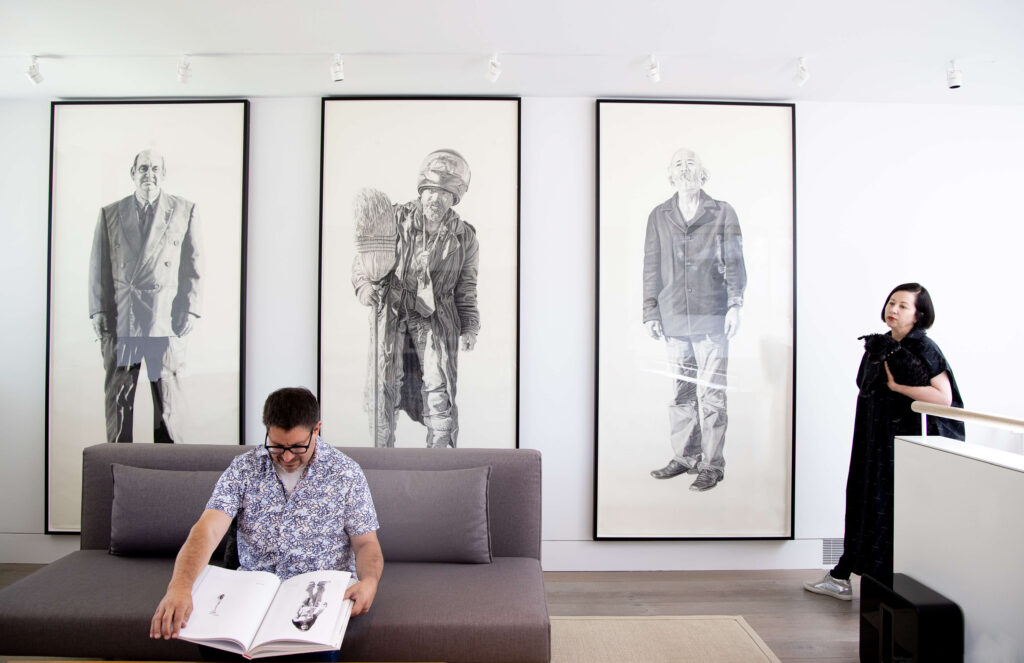
Viewing the art, which is installed in virtually every room, one can see a theme emerge. The Horniks love representational art, specifically portraits. “One reason I am drawn to the figure,” explains Pamela, “is that each one tells a story.” To that end, the couple has purchased art by some major players in the figurative genre: Chuck Close, David Hockney, Andy Warhol, Alex Katz, Robert Mapplethorpe and Cindy Sherman.
As their collecting evolved, however, they also found themselves drawn to emerging artists. “We do have a lot of LGBTQ artists and that has become more and more important to us,” Pamela says. In addition, they have significant pieces by Black American artists and artists from Africa—along with works from Creative Growth, an Oakland-based nonprofit studio and gallery that supports and advances artists with disabilities.
Pamela acknowledges that there is a definite learning curve to collecting art and that initial instincts aren’t always correctly honed. As an example, she shares how she and David considered an early work by Amy Sherrald, who would go on to paint the official portrait of Michelle Obama. They decided not to buy it, which Pamela now says, “was an important collecting moment—who would have known?” They were luckier with American figurative painter Jordan Casteel, who is known for her colossal New York- and Harlem-based portraits, purchasing three of her works for themselves and one for the Cantor Arts Center. “This is a good example of how we are evolving as collectors,” observes Pamela.
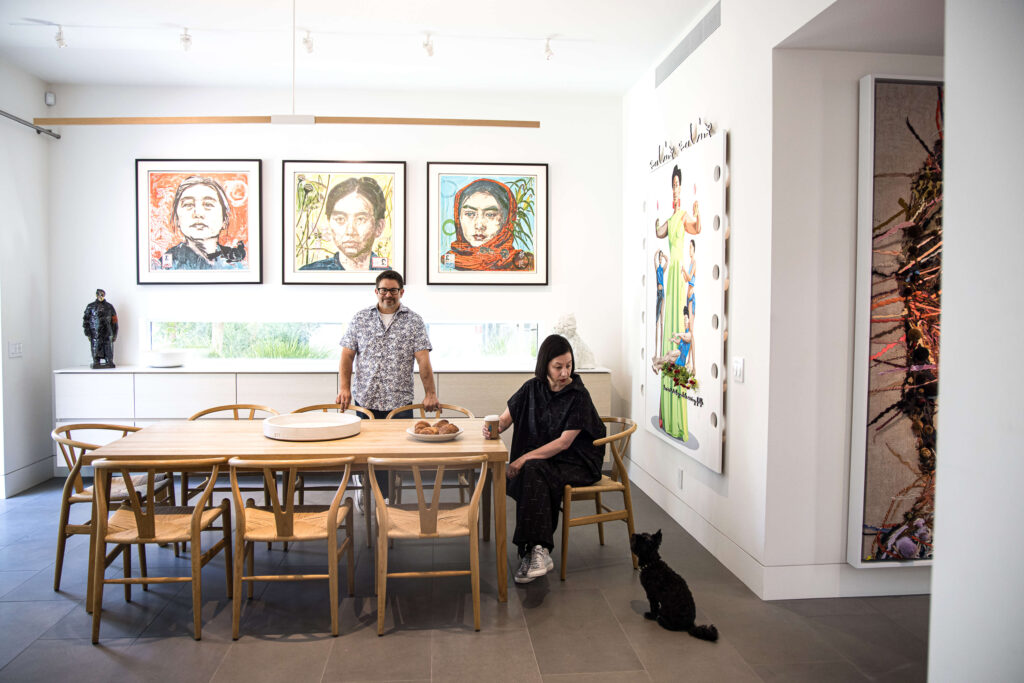
She also shares that the very act of acquiring has involved an evolution of sorts. “I used to get very excited and wanted to play the game, getting dressed up, wearing the best purse and shoes,” she says, referring to the often tony settings involved in the purchase of art. “But now my thinking is, ‘I want the piece, I will be a good steward of the piece and I will one day donate it to a museum.’”
She and David rarely buy art at auction (but if they do, they use Phillips) and prefer to make gallery visits both here and in New York City where they own an apartment. They enjoy establishing personal relationships with artists and, as Pamela notes, “If the artists are alive, and if they want to, they become part of our family.”
Another source that Pamela uses frequently is Instagram, which became a lifeline for her during the past year. “I bought more art than I ever did in my life during the pandemic,” she relays. Often, there were surprises when a work of art arrived that was different than portrayed online. This is what happened with a work by embroidery artist and painter Cayce Zavaglia, which was both large and heavily textured. “We have had a lot of ‘Whoa!’ moments,” Pamela recollects with a smile. When that happens, art is rotated around the house in order to find the perfect installation site. And, she says, they are experiencing the bane of most collectors—running out of space. “It makes me sad to have things in storage, out of sight,” she laments.
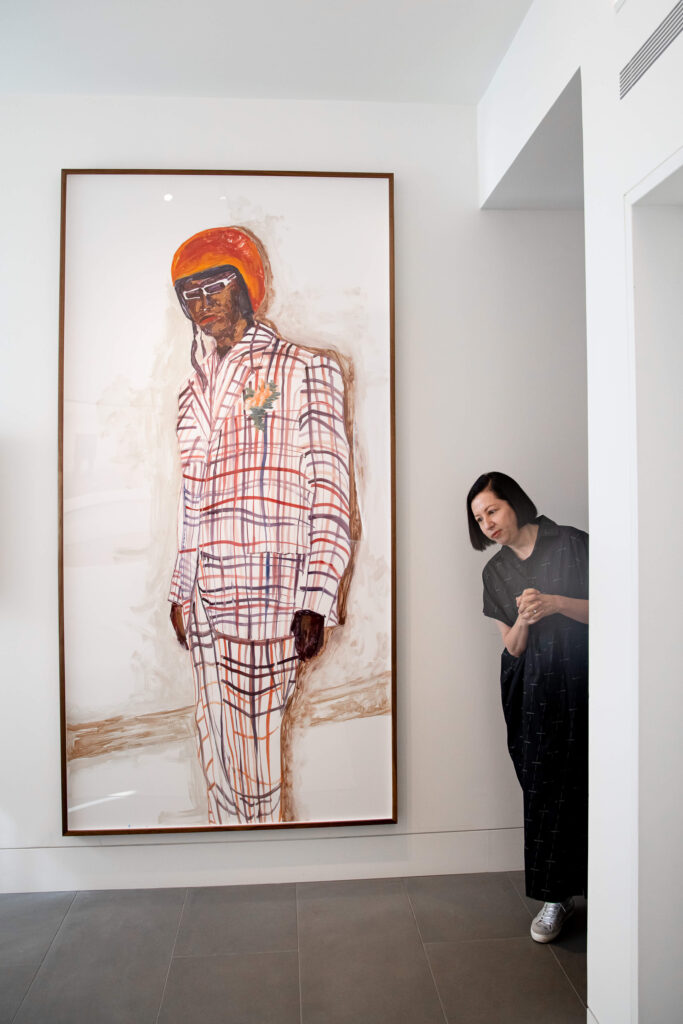
In addition to gallery visits and Instagram, a constant resource for the couple has been the competitions held by the National Portrait Gallery, both in Washington, D.C. and in London. “If you love portraits and collect them,” she observes, “it makes sense to follow who is winning those competitions.” They have acquired work by Berkeley-based artist Lava Thomas and contemporary figurative artist Jiab Prachakul, among others, in this way.
In addition to their collecting activities, the Horniks are also strong advocates for art in other ways. They both sit on boards at Stanford University (Pamela is on the board of both the Cantor Arts Center and the Anderson Collection.) and enjoy supporting artists by sponsoring exhibitions and underwriting books and catalogs. They frequently loan art to museums and galleries and often buy art with the intention of gifting it. “If you have the time and capital to be an art collector,” emphasizes Pamela, “I believe it is your duty to give something back to the public in that way.”
In turn, the Horniks’ commitment to art philanthropy is both publicly recognized and appreciated. As Elizabeth Mitchell, interim co-director of the Cantor, expresses, “The Horniks are incredibly generous to and supportive of the Cantor and exciting to work with because the figural works and portraits they collect are so tuned into the humanity—not just the ideas and styles—of this moment in time.” Karen Kienzle, director of the Palo Alto Arts Center, sums up their contributions this way: “The art world is a much better place with Pamela and David Hornik in it.”

When asked who in the art collecting world has inspired her, Pamela quickly responds, “Hunk and Moo Anderson,” the Bay Area couple who donated the bulk of their 20th-century American art collection to Stanford University. “I love what they did with their collection to make it more accessible,” she adds. Pamela also cites New York philanthropist Agnes Gund: “She is the real deal, donating art and raising consciousness about mass incarceration and the importance of art education.”
Most collectors have a story about “the one that got away” and Pamela is no exception. Although she loves the work of such established masters as Picasso and Cezanne, the painting she wishes she could own is by an artist from Ghana named Amoako Boafo. It is a bright and colorful portrait of a young Black man, clad in a red checked jacket, holding a small dog. “I have a weak spot for art with dogs in it,” she acknowledges, as she affectionately pets her own small rescue dog, Teddy.
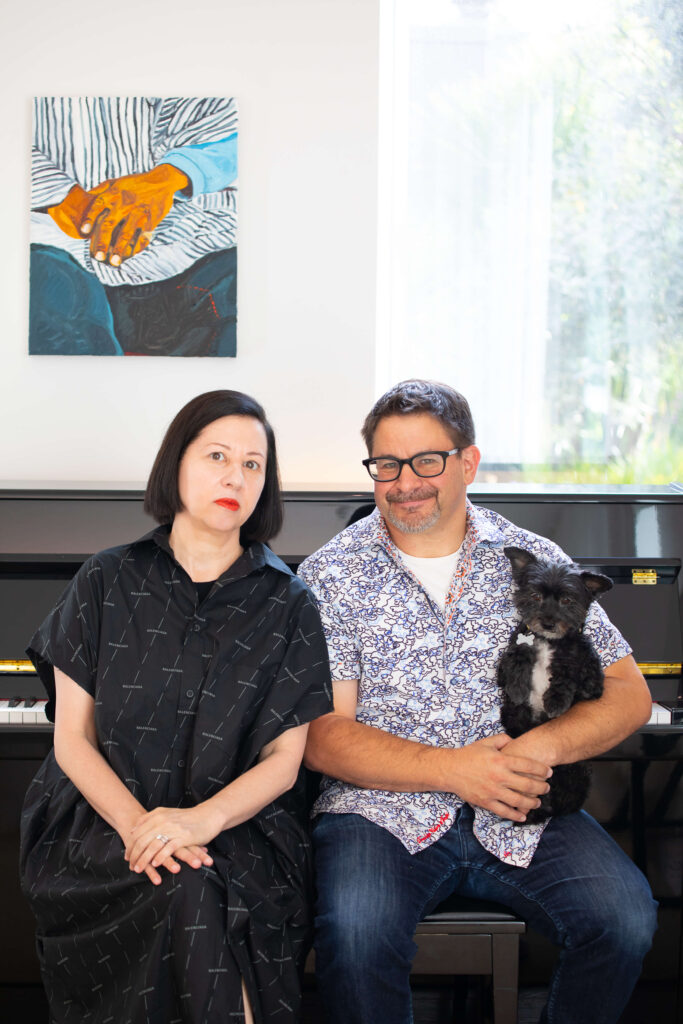
The Horniks say they will continue their pursuit of “obsession organized.” “I want to be more intentional in our collecting,” Pamela adds. “I want it to be meaningful and I want to loan more; it brings me joy to see our art in a museum and to see people viewing it and children on the floor drawing from it.”
Pamela notes that she and David have learned a great deal about how to maneuver around in the art world, which has a reputation for being snobby and notoriously non-transparent. “I have found my place in the Bay Area art world and I feel appreciated by curators and local galleries,” she happily reflects. “I am appreciated for who I am.”
